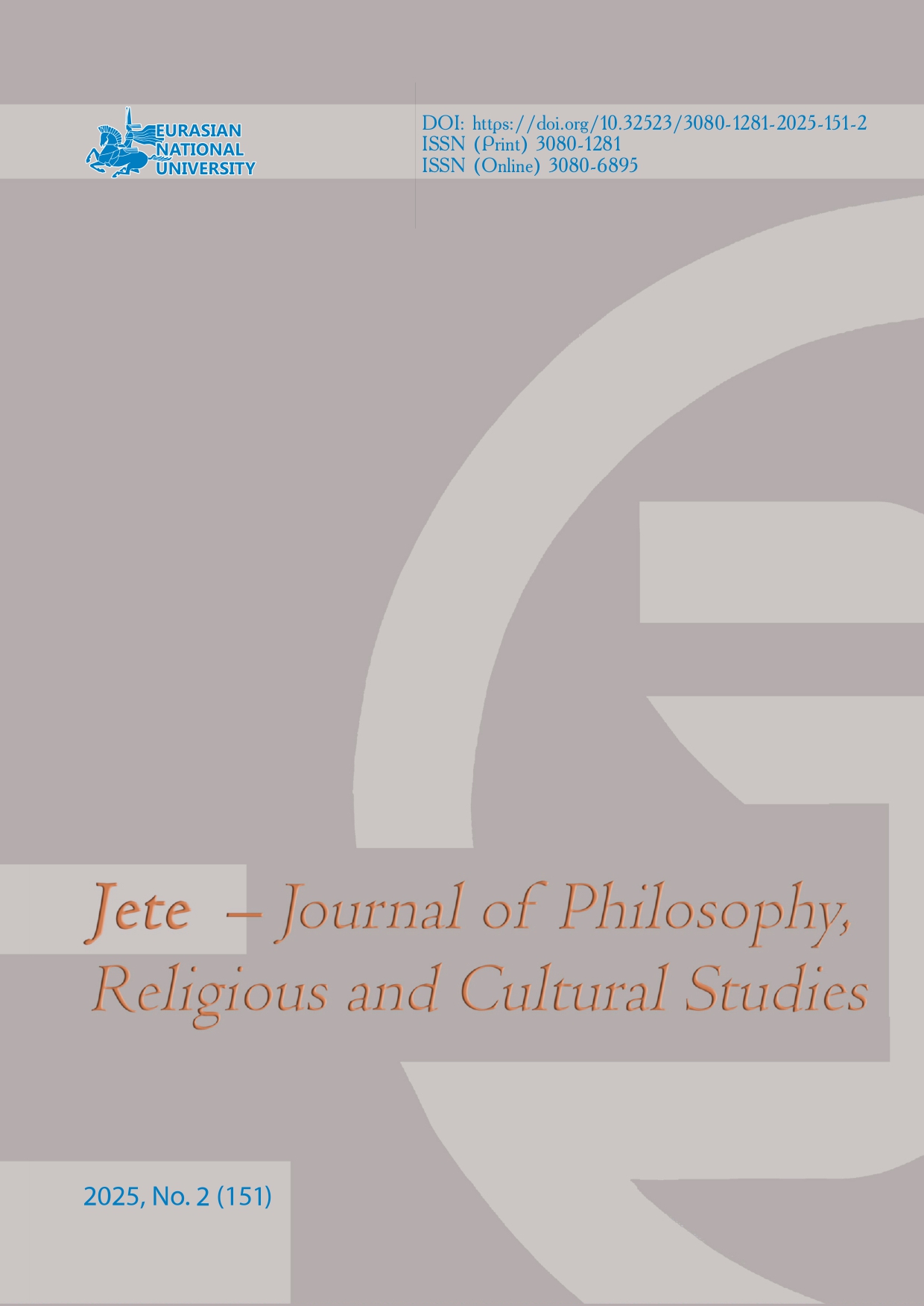THE NONHUMAN TURN: PHILOSOPHICAL AND ETHICAL ASPECTS
Scientific article
Views: 150 / PDF downloads: 82DOI:
https://doi.org/10.32523/3080-1281-2025-151-2-37-59Keywords:
nonhuman turn, "the nonhuman", animal philosophy, ecofeminism, colonialism, ethics, feminist new materialism, posthumanism, ecology.Abstract
The article explores philosophical approaches related to the rethinking of the roles of the human and the nonhuman in the modern world. The emergence of this new field of interdisciplinary posthuman critical studies, known as “the nonhuman turn,” is closely linked to such philosophical directions as object-oriented ontology, posthumanism, and materialism. This approach seeks to expand the boundaries of traditional epistemology, which is rooted in anthropocentrism. It involves the deconstruction of dualistic oppositions such as “human/nonhuman” and “subject/object.” Therefore, a key question is how nonhuman agents such as animals, geophysical processes, technologies, and material systems interact with humans and co-construct reality. As in the posthumanist optic, the boundaries between human and nonhuman are questioned and challenged. However, the nonhuman turn is not about replacing the human with the posthuman, but rather about acknowledging the role of nonhuman entities as active participants in the world. In this context, it explores how non-human entities, from animals to geophysical processes, form a new ethical and philosophical perspective. Themes such as oppression, racism, and sexism also fit into the logic of the “nonhuman turn”. These ideas are represented in ecofeminism, which focuses on politics and oppression. The article focuses on Animal Studies, ecofeminist ideas, and “dark ecology” to highlight the logic of planetary interconnectedness expressed in the “nonhuman turn”. In engaging with the ideas of the “nonhuman turn”, the authors leave open questions about how far we are willing to go in expanding epistemology through the lens of nonhuman agency and in displacing the human from its privileged position. Whether a revival of humanism is possible while preserving the uniqueness of the human. At the same time, maintaining the realization that the modern era requires a more inclusive understanding of the world.
Downloads
References
Adams, C. J., & Gruen, L. (Eds.). (2021). Ecofeminism: Feminist intersections with other animals and the earth. Bloomsbury Publishing USA.
Ahuja, N. (2009). Postcolonial critique in a multispecies world. PMLA, 124(2), 556–563. URL: https://doi.org/10.1632/pmla.2009.124.2.556
Бентам И. Введение в основания нравственности и законодательства. – М.: Росспэн, 1998. – 415 с.
Butler, J. (2009). Frames of war. NY: Verso.
Casselot, M. A. (2016). Ecofeminist echoes in new materialism? PhaenEx, 11(1), 73–96.
Derrida, J. (2006). L’animal que donc je suis (M.-L. Mallet, Éд.). Paris: Galilée.
Деррида Ж. Животное, которым я следовательно являюсь // Социология власти. – 2019. – Т. 31, № 3. – С. 220–275.
Directive 2010/63/EU of the European Parliament and of the Council of 22 September 2010 on the protection of animals used for scientific purposes. URL: https://eur-lex.europa.eu/LexUriServ/LexUriServ.do?uri=OJ:L:2010:276:0033:0079:EN:PDF (accessed: 10.09.2024)
Donovan, J. (1990). Animal rights and feminist theory. Signs, 15(2), 350–375.
Encyclopædia Britannica. Speciesism. URL: https://www.britannica.com/topic/speciesism (accessed:05.03.2025)
Grondin, J. (2007). Derrida et la question de l’animal. Cités, (2), 31–39. URL:https://doi.org/10.3917/cite.030.0031
Grusin, R. (Ed.). (2015). The Nonhuman Turn. University of Minnesota Press.
http://www.jstor.org/stable/10.5749/j.ctt13x1mj0
Haraway, D. J. (1991). A cyborg manifesto. In Simians, cyborgs, and women (pp. 149–181). NY: Routledge.
Harris, M. (2003). Colored pictures: Race and representation. University of North Carolina Press.
Harvey, D. (1997). The condition of postmodernity. Cambridge, MA: Blackwell.
Латур Б. Наука в действии: Следуя за учеными и инженерами внутри общества. – СПб.: Изд-во Европейского университета, 2013. – 414 с.
Латур Б. Пересборка социального. Введение в акторно-сетевую теорию. – М.: Litres, 2022. – 384 с.
Massumi, B. (1995). The Autonomy of Affect. Cultural Critique, 31, 83–109 URL: https://doi.org/10.2307/1354446
Massumi, B. (2014). What animals teach us about politics. Duke University Press.
Мортон Т. Стать экологичным. – М.: Ad Marginem, 2019. – 240 с..
Morton, T. (2015). They are here. In R. Grusin (Ed.), The nonhuman turn (pp. 167–192). University of Minnesota Press. URL: http://www.jstor.org/stable/10.5749/j.ctt13x1mj0.10
Muzur, A., Rinčić, I. Fritz Jahr (1895–1953) — the man who invented bioethics. Synthesis philosophica, 51, 2011. 133–139 рр. URL: https://core.ac.uk/download/pdf/14440839.pdf (accessed: 10.02.2025)
Painter, N. I. (2010). The history of White people. NY: W.W. Norton & Co.
Regan, T. A case for animal rights. In M. W. Fox & L. D. Mickley (Eds.), Advances in animal welfare science 1986/87 (pp. 179–189). Washington, DC: The Humane Society of the United States. URL:https://www.wellbeingintlstudiesrepository.org/cgi/viewcontent.cgi?article=1003&context=acwp_awap (accessed: 10.03.2025)
Russell, W. M. S., Burch, R. L. (1959). The principles of humane experimental technique. Methuen. URL: https://caat.jhsph.edu/the-principles-of-humane-experimental-technique/ (accessed: 09.10.2024)
Sedgwick, E. K., & Frank, A. (1995). Shame in the cybernetic fold. Critical Inquiry, 21(2), 496–522.
Sheldon, R. (2015). Form / Matter / Chora: Object-oriented ontology and feminist new materialism. In R. Grusin (Ed.), The nonhuman turn (pp. 193–222). University of Minnesota Press. URL: http://www.jstor.org/stable/10.5749/j.ctt13x1mj0.11
Singer, P. (1993). Practical ethics (2nd ed.). Cambridge University Press.
Singer, P. (2023). Animal Liberation Now: The Definitive Classic Renewed. Harper Perennial.
Сингер П. Освобождение животных. – М.: Синдбад, 2021. – 448 с.
Sofoulis, Z. (2015). The cyborg, its Manifesto and their relevance today: Some reflections. Platform: Journal of Media and Communication, 6(2), 8–15. URL: https://doi.org/10.25595/115
Спиноза Б. Этика. – М.: РИПОЛ классик, 2020. – 396 с.
Тимофеева О. Что нас ждет за поворотом к нечеловеческому? // Новое литературное обозрение. – 2019. – № 4. – С. 26–34.
The New York Declaration on Animal Consciousness. (2024). URL: https://sites.google.com/nyu.edu/nydeclaration/declaration
Швейцер А. Этика благоговения перед жизнью // Культура и этика. – М.: Республика, 1992. – С. 304–327.
Швейцер А. Философия и движение в защиту животных // Этическая мысль. – 2020. – Т. 20, № 2. – С. 154–159.
Штегер, Ф. Европейская концепция биоэтики Фрица Яра (1895–1953) и возможности её применения. URL: https://cyberleninka.ru/article/n/evropeyskaya-kontseptsiya-bioetiki-fritsa-yara-1895-1953-i-vozmozhnosti-ee-primeneniya (дата обращения: 10.04.2025)
Downloads
Published
Data Availability Statement
This study used the sources presented in the list of references. They are publicly available on various websites.
Issue
Section
License
Copyright (c) 2025 Улболсын Сандыбаева, Даметкен Толгамбаева (Автор)

This work is licensed under a Creative Commons Attribution-NonCommercial-NoDerivatives 4.0 International License.













